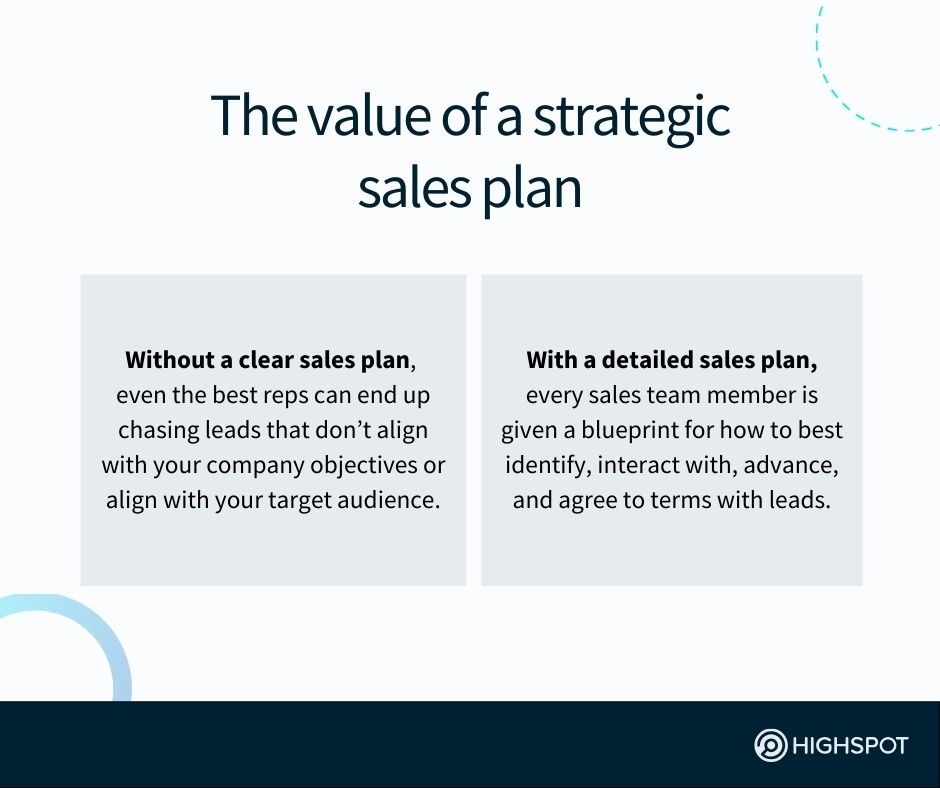Key Takeaways
- The success of your entire sales plan is predicated on your go-to-market (GTM) leaders’ ability to collaborate closely and communicate constantly with one another and tie your efforts to revenue goals.
- Robust sales data tied to reps’ historical performance, insights into your target market, and details regarding your annual business plan and goals for the year ahead can help you build a strong sales plan.
- While your sales team leverages content and messaging in their engagement plays, your GTM leaders must routinely assess whether your sales plan is hitting the mark so you can scale what works.
The annual sales planning process at your company is a highly collaborative and detail-oriented endeavor. Your go-to-market leaders, C-suite, and other key business stakeholders meet to map out revenue-growth strategies for the year ahead.
But it’s important to remember it’s not a set-it-and-forget-it activity.
Effective sales planning is an ongoing practice that requires frequent recalibration to ensure you create a sales plan that continually moves the needle. Consider the two types of changes that can impact the intricacies and outcomes of your sales plan:
- Internal shifts—think product launches, evolving product roadmaps, revised revenue targets, and new-market penetration—regularly influence strategy.
- Similarly, external dynamics, like changing macroeconomic conditions and fresh competitive intel, can quickly transform your sales plan and, in turn, require you and your sales reps to pivot accordingly.
A modern B2B sales leader such as yourself understands that adaptability and continuous refinement are essential to success. If you treat your sales plan as a static blueprint, it’ll quickly become obsolete. Instead, you should regularly revisit your strategic direction, adjusting your tactics in response to new developments.
Adding another layer of complexity, sales planning increasingly relies on AI, analytics, and automation today—not just historical data in your customer relationship management (CRM) system—to help sales and marketing teams plan shrewdly.
The best AI sales tools today specialize in:
- Identifying customer engagement patterns leveraging conversation intelligence
- Anticipating leads’ actions and needs, based on sales data tied to each deal stage
- Improving reps’ selling behaviors and cadences by offering just-in-time guidance
By embracing AI-driven go-to-market solutions with smarter analytics and intelligent sales automation, your GTM leadership can respond more quickly and strategically to emerging opportunities, improving both forecast accuracy and revenue outcomes.
The key to making the most of AI-powered insights in your sales planning and implementing automated workflows for sales team execution, though, is ensuring you have interconnected go-to-market data across your GTM technology ecosystem—and a leading enablement platform at the center of your tech stack.
What is a sales plan?
A sales plan is your roadmap for the year ahead that clearly outlines how your sales team will reach revenue goals, charting out each step so you’re never left wondering what comes next.
Think of your strategic sales plan like your GPS that factors in deal insights, enablement data, market trends, revenue goals, and other information to guide and equip your reps to best engage target customers across each stage of the sales cycle.
- Without a clear sales plan, even the best reps can end up chasing leads that don’t align with your company objectives or align with your target audience.
- With a detailed sales plan, every sales team member is given a blueprint for how to best identify, interact with, advance, and agree to terms with leads.
When you create a sales plan, you’re essentially translating your broader business plan into actionable steps your salespeople can carry out in their day-to-day sales prospecting.
What’s more, a good sales plan relays how marketing, sales, enablement, revenue, and customer success will work together to attract, engage, and retain your target customers, factoring in both the pre-sale and post-sale process.

5 stages of the sales planning process
Though there is certainly variation from one business to the next, the most effective sales planning processes still abide by the five traditional sales plan stages:
| Sales planning stage | What it entails | Who is involved |
|---|---|---|
| 1. Define your sales goals | – Align with business priorities/targets – Set short- and long-term quotas – Tie goals to business revenue metrics | – Sales leaders – RevOps – Executive team |
| 2. Review recent progress | – Review last year’s wins and misses – Uncover gaps across sales activities – Shape realistic expectations with data | – Sales managers – Enablement – Analytics team |
| 3. Map your GTM strategy | – Identify the top customer segments – Decide on outreach and channel mix – Align sales tactics to buyer journeys | – Product marketing – Sales leaders – Customer success |
| 4. Craft an execution plan | – Assign roles and quotas by territory and target-audience segment – Develop plays and training plans – Set timelines and reporting cadence | – Enablement – Field teams – Regional sales directors |
| 5. Monitor, adapt, repeat | – Track performance against your plan in real-time and on rolling cadence – Adjust based on market changes – Optimize based on what’s working | – RevOps – Marketing – GTM leaders |
The common thread across all five strategic sales plan stages? Communication.
Without a dedicated sales communications strategy, it’s impossible to ensure everyone across your go-to-market functions is working in harmony at all times.
From initial strategy sessions to weekly update calls, all go-to-market leaders involved in building and executing your strategic sales plan must be on the same page about responsibilities and desired results to avoid experiencing what Harvard Business Review contributor Andrea Belk Olson calls “translation leak points.”
“When an idea passes unchanged from conception to execution, the result isn’t just better communication,” Andrea wrote. “It’s better business performance.”
The impact of successful sales planning
‘Fail to plan, plan to fail’ is a popular mantra in the business community for good reason. Having a directionless sales strategy and unfocused sales teams only leads to missed targets, operational inefficiencies, and wasted resources.
On the flip side, the most successful sales plan has certain key elements that ensure sales organizations row in the same direction as the rest of their companies.
Company mission, vision, and goals factored in
A comprehensive sales plan shouldn’t exist in a vacuum. When it’s built to reflect your company’s mission and broader business objectives and you’re defining sales targets, every team knows where the finish line is—and why it matters.
Today’s B2B sales organizations only thrive when their daily grind ladders up to something bigger. By weaving in that strategic direction early, you help your sales reps connect the dots between their pipeline and purpose.
Aligned sales strategy and marketing strategy
When marketing and sales play from the same sheet of music, magic happens. A well-synced, overall sales strategy ensures go-to-market efficiency. Campaigns, content, and conversations all support the same business goals. That means fewer mixed signals, better conversion rates, and a much smoother buyer journey.
For enterprise companies like yours, alignment like this turns chaos into clarity—and clutter into closed-won. (That said, the appropriate marketing and resources and sales tools must still be supplied to both teams to ensure strong sales performance.)
Enhanced likelihood of hitting revenue targets
Let’s be honest: Everyone’s chasing the number. A comprehensive sales plan gives teams the structure, focus, and accountability to actually get there. With clear priorities and achievable sales quotas, your sales manager isn’t guessing—they’re guiding.
Layer in the right sales enablement tools, and suddenly you’ve got a well-oiled machine that knows exactly how to meet (and beat) those targets.
Improved sales performance by BDRs and ADRs
Reps can’t crush quota if they don’t know where to focus. A strong sales-plan-developing process translates into smarter sales efforts—especially for BDRs and ADRs on the frontlines.
From outbound strategy to play-related sales messaging, everything gets sharper when near- and long-term sales initiatives are baked into the plan.
When reps are clear on the “what” and “why,” performance follows.
Clearer sales forecasting to increase revenue
Forecasting shouldn’t feel like a finger-in-the-wind exercise. A solid, data-backed sales plan helps teams set realistic sales targets—and actually stick to them. With better visibility into pipeline health, your sales managers and sales leaders alike can course-correct fast and better predict deal flow with confidence.
That clarity is essential to hitting those numbers, fueling revenue growth at scale, and ensuring your go-to-market strategy is a well-oiled machine.
Creating a sales plan template in 7 steps
Read to build an effective sales plan that turns high-value prospects into paying customers? This template can act as a helpful blueprint for your GTM team.
1) Reassess your ideal customer profile and target audience
Kick things off by pressure-testing your ICP. Is your current target audience still the best fit? Buyer needs change fast—especially in crowded markets—so make sure your sales plan reflects realities, not last year’s assumptions.
Also, rethink who your reps should be talking to, how they talk to them, and what messaging resonates. Modern B2B sales strategies aren’t one-size-fits-all. Get specific, sharp, and aligned with what’s actually working.
2) Map out how sales goals will align with business strategy
If your sales plan doesn’t ladder up to your company’s big picture, it’s just noise. Sales goals should snap right into place with your company mission, business priorities, and those all-important shared marketing and sales objectives.
Don’t just chase a number. Rather, build toward a destination. When reps know how their quotas connect to the company’s success, motivation and execution go up. That’s how you turn your sales strategy from vague to laser-focused.
3) Account for go-to-market initiatives and product launches
Surprise product launches and campaign fire drills are the fastest way to derail momentum. Your defined sales plans should give sales teams a heads-up on what’s coming—from major go-to-market pushes to niche product rollouts.
This is where coordination matters: Marketing needs to know what sales is saying, and sales needs the content, timing, and messaging ready to go. Build your sales plan with visibility into upcoming priorities so everyone rows in the same direction.
4) Spend time with sales leadership analyzing market trends
Let’s be real: Your sales planning isn’t complete without input from the people leading the charge. Sit down with everyone in GTM leadership and take a hard look at what’s happening across your deals, competitors, and industry trends.
The goal? Spot patterns, flag risks, and get ahead of what’s changing. Great sales leaders see the cracks before the numbers show it. So, use your perspective to sharpen your plan, strengthen your sales process, and stay a step ahead.
5) Ensure your sales organization has the resources to execute
Planning is the easy part. Execution is where things fall apart. A good sales plan only works if your sales organization is set up to actually deliver. That means making sure your sales operations team has what they need, your reps are trained and prepped, and your cutting-edge sales tools are ready to go.
Don’t build a plan that relies on magic. Build one that relies on readiness.
6) Pick sales metrics to track (knowing you can update later)
Sales planning without clear metrics is like coaching without a scoreboard.
Don’t try to track everything. Instead, only track what matters. Choose sales performance metrics that align with your goals, show progress throughout the sales process, and help reps make smarter moves.
From conversion rates, to sales velocity, to pipeline health, pick the ones that truly signal performance. Realistic sales targets only matter if you know how you’re pacing toward them.
“Strong sales leaders can think analytically, stay data-focused, and identify necessary areas of improvement or opportunity,” according to Highspot’s What Good Sales Management Strategy Looks Like guide. Translation: Select KPIs that (seemingly) matter most, but remember you can always revisit them.
7) Leverage AI and other sales plan examples to optimize
No B2B sales process or plan is likely to flourish today without AI woven into the fabric of reps’ day-to-day selling, new-sales-hire training, and managers’ ongoing coaching. By taking advantage of leading tools that offer AI for sales reps, you can ensure your:
- Reps can best connect with leads in your target market at the right places and times
- Managers can coach up sellers to ensure they stay on track to hit SMART sales goals
- Marketers can track what collateral and messaging the sales team uses to win deals
- Enablement can refine plays so they have a bigger impact on your sales strategy
“By embracing AI strategically, sales leaders can create agile, responsive and highly effective teams able to offer increasingly precise, personalized and impactful sales strategies,” Forbes Business Council member Puneet Gaur recently wrote.
Strategic sales planning FAQs, answered
In addition to questions around seemingly minor sales process improvements you could make, you may have Qs about bigger-picture, long-term strategic planning.
We’ve got you covered. Here are some quick-hit answers to frequently asked questions we often hear around how to create a sales plan that helps reps close new business (and even enables customer success to keep existing customers).
How often should I revisit and revise my strategic sales plan?
Revisit your sales plan at least quarterly. Market shifts, customer data, and sales pipeline changes demand it. Your sales department needs flexibility to adapt fast. Build revision into your sales planning process—don’t leave it to gut checks.
Which sales plan KPIs do GTM leaders use to track progress?
Top KPIs include pipeline coverage, deal velocity, win rates, and rep attainment. Sales managers also track ramp time and forecast accuracy. Choose KPIs that match your revenue targets and sales process. Align metrics to what moves the needle most.
Can AI help our sales planning and related sales strategies?
Yes, AI can help spot gaps, surface insights, and automate tasks. Use it to analyze rep performance, flag trends, and adjust sales plans in real time. Some AI sales enablement tools, like Highspot, which integrates directly with Salesforce and other essential GTM solutions, remove guesswork from your sales planning.
It’s a game-changer for future sales.
What’s the best way to set ambitious but realistic sales goals?
Start with past performance, market data, and sales plan examples. Involve your sales managers and RevOps team to balance ambition and feasibility. Tie goals to sales reps’ capacity and real opportunity. A good sales plan is bold, not blind.
How can our sales leaders get sales plan buy-in from our reps?
Make reps part of the planning process. Show how the plan supports their success and growth. Connect sales goals to real incentives and career impact. Sales reps commit faster when they help shape what’s expected of them.
What pitfalls should our team be mindful of in our sales plans?
Avoid unclear goals, missing enablement, and disconnects between GTM teams. Overlooking rep capacity or customer data leads to misses. Don’t make it too lofty—ground your goals in what’s real. An effective sales plan is equal parts stretch and structure.
Should we work with customer success to build our sales plan?
Customer success has insights into what keeps target customers who ultimately convert into paying customers engaged and growing. Their input sharpens the sales planning process and can inform your account-based selling strategy. Strong post-sale feedback improves pre-sale execution, so share it with your sales team.
How can we leverage sales forecasts to create future plans?
Use past performance to predict future sales and revenue growth. Keeping accurate, up-to-date records of all deals—won, lost, and no-decision—and engagement efforts by your reps, account executives, account managers, and customer success teams can all help mold and shape next year’s sales plan and ensure accurate sales forecasting on an ongoing basis.




